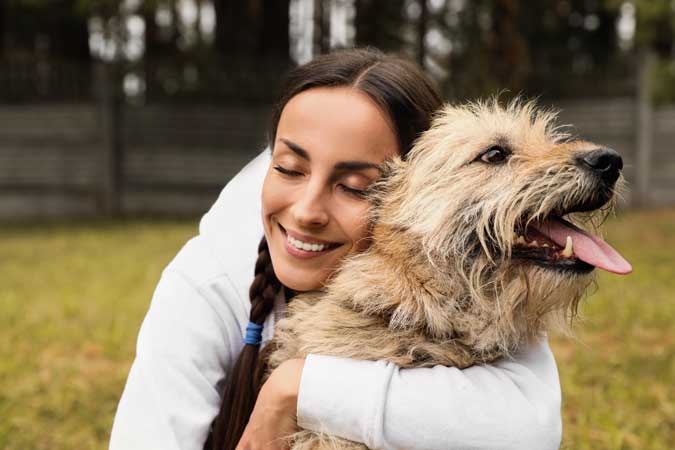Pure Breeds Vs. Mixed Breeds

UPDATED – 11/10/2022
When it comes to choosing a dog, the breed is probably one of the first thing you'll consider. The American Kennel Club (AKC) recognizes 195 different dog breeds, but there are actually countless others in existence, not to mention all the different kinds of mixes. In this article, we're going to cover the differences between purebred dogs and mixed breeds to help you have the information you need when choosing the perfect dog for you!
What is a Purebred Dog?
Purebred dogs are those who come from parents, grandparents, etc. that are all the same breed. Breeding first came about when people would pair dogs who had similar traits so that they could create offspring with these specific traits (such as the ability to run fast, guard property, hunt, pull sleds, etc.). From here, the best puppies in the litter were then selected to be the ones to breed the next litter, and so on. You might hear this process referred to as "cultivating varieties."
A true purebred will have pedigree that traces back to its ancestors. Be aware that even though someone may claim to be selling a purebred, you will want to be sure that they will have the proper papers and pedigree. This will not only prove that they are indeed purebred, but you will also have access to other important information, such as inbreeding (more on this topic below).
Pros of Pure Breeds
There are advantages and disadvantages to owning a purebred dog. One of the pros of having purebred dogs is predictability. With a purebred dog, you're more likely to know what you're getting when you buy a puppy. Knowing what to expect of your dog's temperament may make your dog easier to train based on the standards of the dog's breed group (sporting group, hound group, terrier group, working group, toy group, herding group, non-sporting group). While all individual dogs are different, you're less likely to be surprised when it comes to temperament, eventual size, and grooming or medical needs. For example, almost 20% of German Shepherds develop the skeletal condition, hip dysplasiam, which can cause chronic pain and limping. Anticipating the needs of your purebred dog will better help you prepare to address them. Because pure breeds are so predictable in their behavior, purebreds tend to make better rescue and service dogs.
Another pro is that purebreds are the only dogs that can compete in dog shows. If participating in dog shows is something you are looking to get in to, then you'll want to get a purebred puppy.

Cons of Pure Breeds
There are a few drawbacks when it comes to owning a purebred dog. One of the most common concerns is inbreeding. Inbreeding is when dogs have been have been bred with close relatives for generation after generation. Though purebred dogs are sometimes mated with relatives to ensure their offspring is also purebred, having dogs mate with very close relatives (such as siblings) can cause genetic defects and other issues in future litters. They can even start to lose the traits that they were bred for in the first place!
Another con of purebred dogs is that they can be the result of unethical breeding practices. For example, many canines are bred in puppy mills which are known for their poor conditions and inhumane treatment of dogs. Those who are selling dogs from puppy mills may claim that their dogs are purebred (and charge high prices) when really, they offer no proper pedigree with no way of knowing.
When it comes to puppy scams, there are a number of red flags to watch out for. Sometimes, supposed breeders won't conduct business by phone but instead will rely on email only to handle communications. Fake breeders will use stock photos found elsewhere on the internet to advertise the puppies they are "selling." You can reverse-search the text and photos listed to see if they appear elsewhere online. Questionable breeders will also insist on a non-secure method of payment, which will make it harder for you to get your money back should the deal turn out to be fake. Speaking of payment, a price that is too good to be true probably is. Know the price range for the breed you're interested in buying, and make sure the breeder you have in mind is asking a fair-market price. Finally, you should reject any breeder's claim to have a "breeder badge" from the American Kennel Club (AKC), as the AKC does not hand out such badges.
Last of all, purebred dogs are expensive, costing upwards of $1,500! Keep this in mind while you're searching for the perfect dog for you.
What is a Mixed Breed Dog?
Mixed breeds are the result of two different breeds of dogs mating and having puppies. Mixed dogs (sometimes called mutts) are very common and are more often found in shelters than purebred dogs. They don't have a pedigree, so most of the time, you won't be able to know their genetic history. This is usually no problem, but just be aware that mixed breeds aren't able to compete in dog shows or have purebred puppies.
Pros of Mixed Breeds

The first pro of mixed breeds is that they have a more diverse gene pool. Because they come from two very different lineages, it can put them at a lesser risk of genetic problems and disorders in comparison to purebred dogs who are inbred. Remember, though, that mixed breeds are not guaranteed to be healthier or live longer then purebreds. All dogs come from different backgrounds and situations, and health issues can arise at any time in their life.
Secondly, another pro of mixed breed dogs is that they are unique! If you've been wanting a dog that has original physical features, then you may want to consider getting one that is the result of the mix of two or more breeds. The combination of breeds is endless, and the resulting puppies are every bit as cure at pure breeds.
Last of all, because mixed breeds are often found in shelters, adopting a mixed breed dog ensures that they are getting a home! Shelters can become overcrowded quickly due to the number of homeless and unwanted dogs there are. Rescuing a dog from a shelter, then, is a great way to provide them with a loving home where they can live their best life! Adopting from a shelter is also relatively inexpensive. Shelter or animal rescues will charge a modest adoption fee – or sometimes even waive the adoption fee altogether! As part of the adoption process, they'll also want to check to make sure that the dog is going to a good home. The process is simple, straightforward, and ethical. By adopting from a no-kill shelter, you are saving one life and helping to create room for another dog in that facility.
Cons of Mixed Breeds
The biggest con of mixed breeds is that they are not as predictable as pure breeds. Because they come from parents who may have different behaviors and tendencies, or because you may not know their parental history at all, it's hard to know how your mixed breed dog will react to various situations. This can make is difficult to know how it will behave around young children and other dogs or pets in the home. With mixed breeds, you also may not know how big they will get. These are a few things to keep in mind while searching for a good fit. A mixed-breed dog will bring with it a number of unknowns, but these surprises can be part of the fun of owning a mixed breed dog.
Conclusion
As you can see, there are pros and cons to both purebred and mixed breed dogs. Most of the time, when people are considering what dog breed they want to adopt, mixed breeds are not at the forefront of their mind. However, mixed breeds make great pets and shouldn't be discounted.
What kind of dog you get, though, really depends on your needs and should be a personal decision. Before you adopt one, be sure you assess your wants, needs, and expectations and talk through them with other members of your household. Hopefully this will help you make the right choice and find the perfect pup for you!
Additional Resources:
Previous article

Next article

Related posts
View all-

National K9 Veterans Day: Why and How to Celebrate
National K9 Veterans Day is celebrated every year on March 13th. This year its on Saturday March 13th, 2024. This day was established to recognize and celebrate the contributions that Military Working Dogs.
Read Article -

Puppy Training Tips
Training your pup from day one helps set a solid foundation for good behavior and a well-adjusted adult dog. Puppies thrive on structure, and a predictable routine makes learning easier.
Read Article -

Spring Cleaning Tips for Pet Parents
Say goodbye to the winter germs and hello to all the new spring smells! The beginning of spring is the perfect time to clean your house. For pet owners, this can mean more in-depth cleaning in areas other people don't have to worry about. We will give you some helpful tips and tricks so that cleaning up after your pet seems a little less daunting. Read Article



